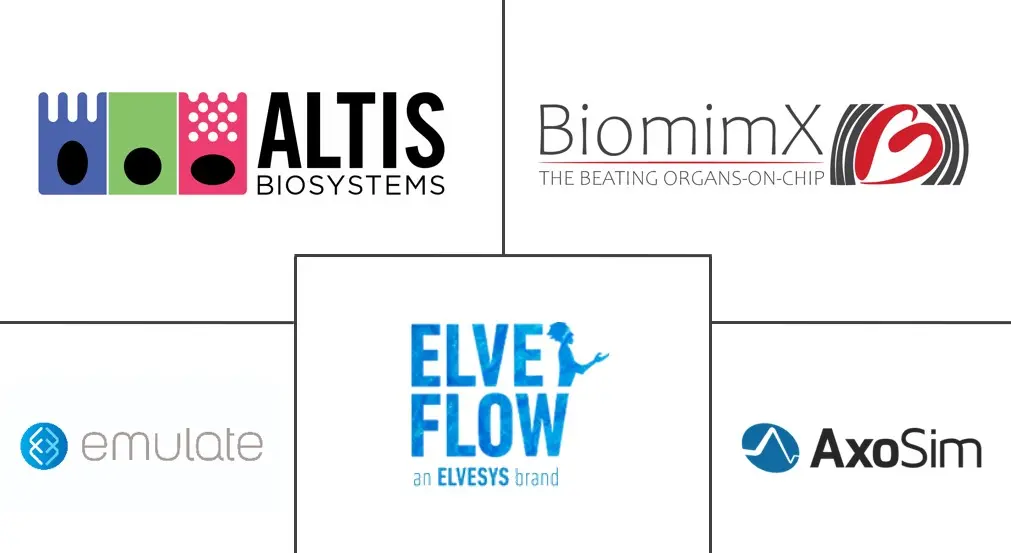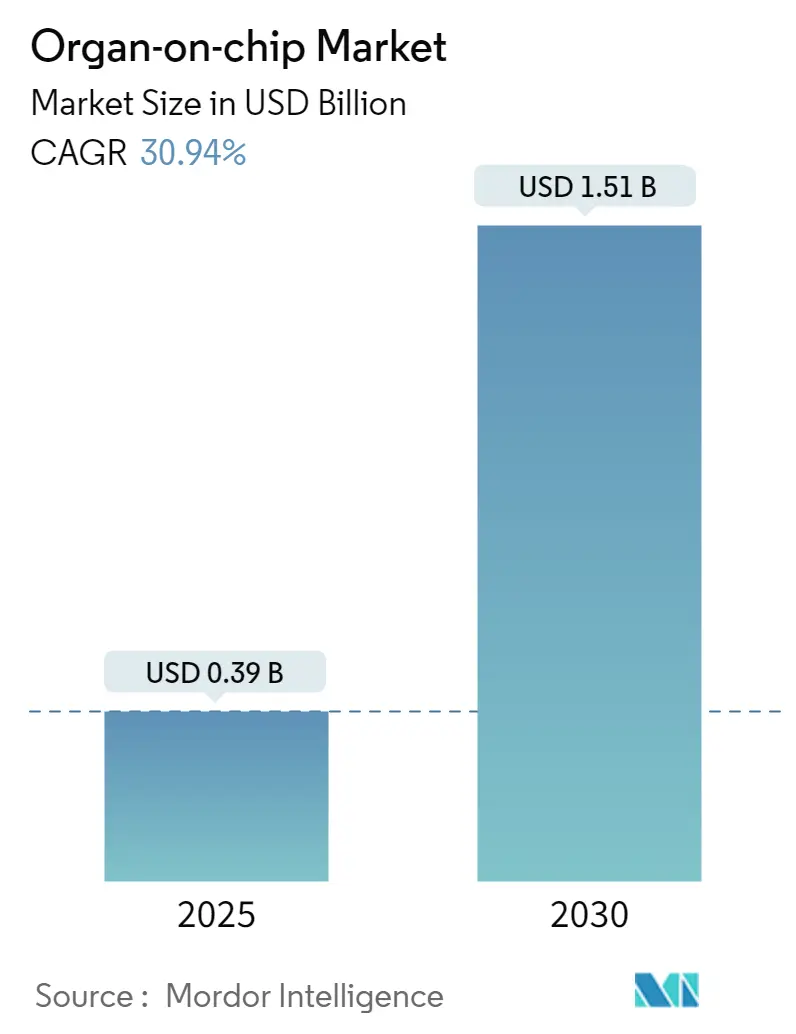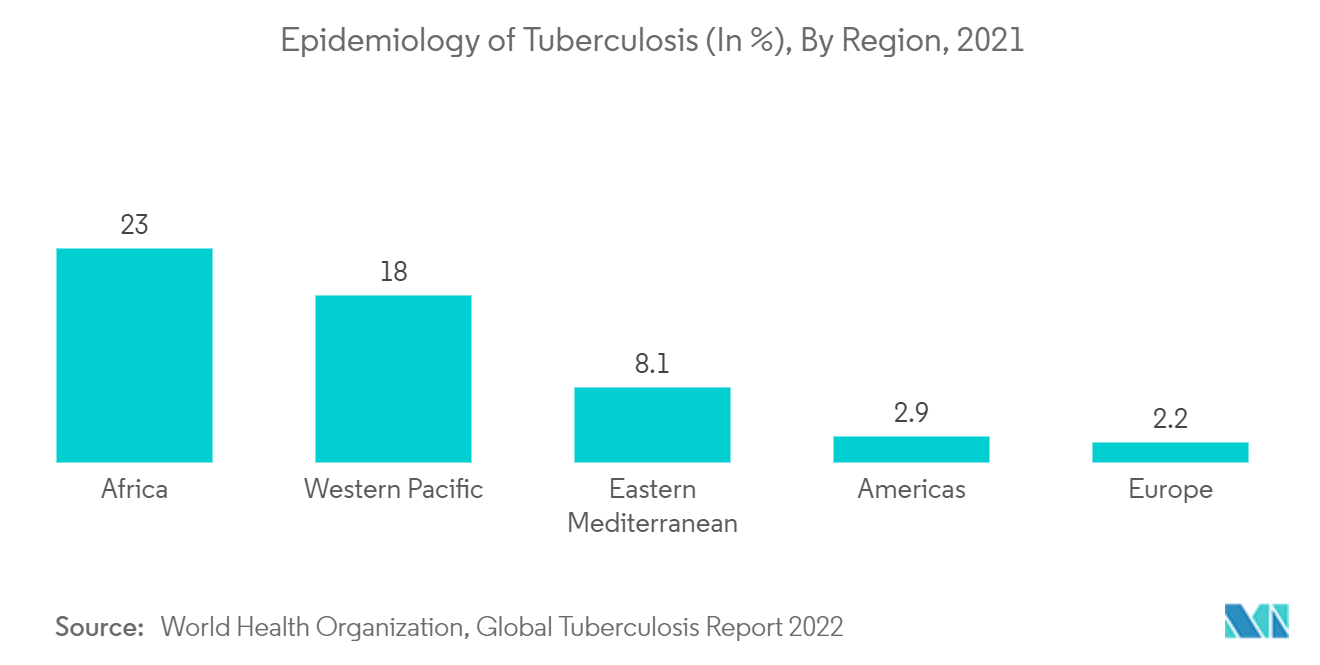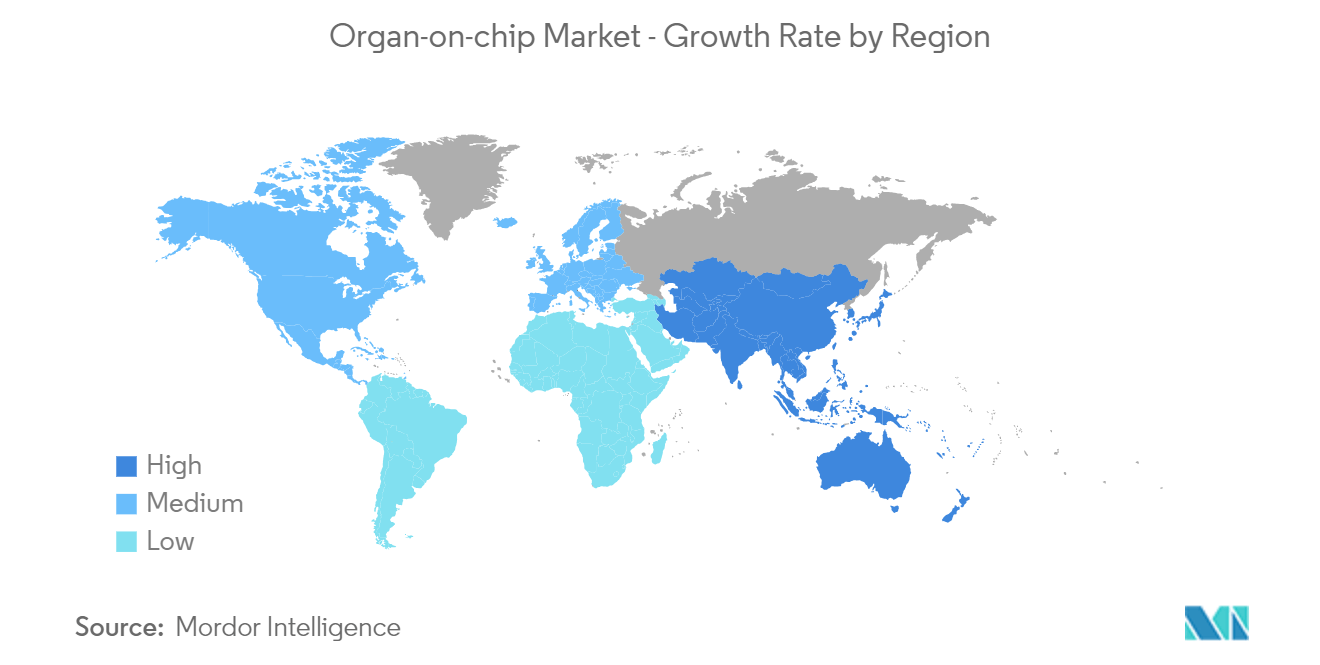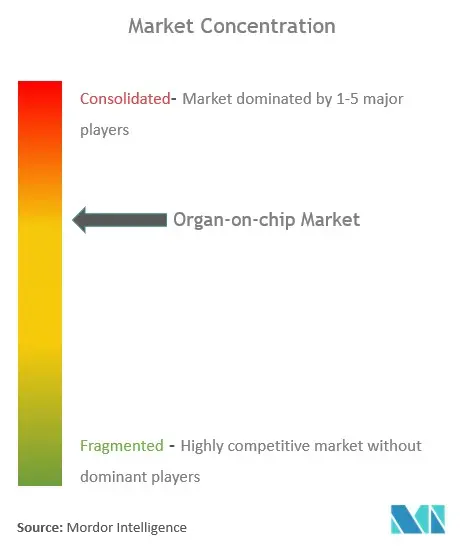Organ-on-Chip Market Analysis
The Organ-on-chip Market size is estimated at USD 0.39 billion in 2025, and is expected to reach USD 1.51 billion by 2030, at a CAGR of 30.94% during the forecast period (2025-2030).
An Organ-on-a-Chip is a Microfluidic Cell Culture device that contains continuously perfused chambers. This chip develops narrow channels that mimic the blood and airflow in organs, such as the Lung, Gut, Liver, Heart, and other organs, effectively creating Lung on Chip, Gut on Chip, Liver on Chip, and Heart on Chip systems. Such devices produce multiple levels of tissue and organ functionalities, serving as In Vitro Organ Models, which are not feasible using conventional 2D and 3D culture systems. It offers a wide range of applications, such as disease modeling, patient stratification, and phenotypic screening, making it valuable in Organ Tissue Engineering. The Organ-on-Chip market is driven by factors such as a requirement for alternatives for animal testing and the need for early detection of drug toxicity along with new product launches and advancements in technology that are also responsible for driving the market. For instance, in December 2021, Emulate, Inc., stated that its Brain Chip, a leading product in the Brain on a Chip market, was sent to the ISS National Lab to study the effects of microgravity on human brain physiology as part of the tissue-chips in space initiative sponsored by the NCATS at NIH and the ISS-NL.
Furthermore, in September 2021, Fidia Farmaceutici S.p.A. and BiomimX Srl signed a research collaboration agreement aimed at introducing and applying new Organs-on-Chips based technological solutions to the intra-articular medical device discovery process. Moreover, in November 2021, AIM Biotech launched the idenTx 40 Plate, a high-throughput Organ-on-a-Chip system contributing to the growth of the Organ-on-Chip Systems market, that lets researchers at biotechnology and pharmaceutical companies faithfully recreate the function of human organs and tissues without using animals for research. The demand for personalized medication and the vast applications of Organ-on-Chip beyond the pharmaceutical industry are the major factors creating growth opportunities for Organ on Chip Companies.
However, the complexity of Single Organ on a Chip Models may hinder market growth over the forecast period.
The research community and the biopharmaceutical industry have mobilized with unprecedented speed against the COVID-19 pandemic. Hence, Organ-on-Chip technology was found to be one of the most promising and go-to technologies during the development of treatment and prevention options that were then under clinical studies for the SARS-CoV-2 infection. For instance, in March 2022, using a novel Human Organ on Chips platform, a research team from the University of Toronto's Faculty of Applied Science & Engineering identified a molecule (QHREDGS) with the potential to combat one of the most severe complications of COVID-19 infections. The new ongoing research studies of Organ-on-Chip for the treatment of COVID-19 are expected to have a positive impact on the Organ-on-Chip market over the coming years.
Organ-on-Chip Market Trends
Lung-related Application is Expected to Exhibit a Significant Market Growth Over the Forecast Period
The Lung on a Chip Technology is a complex, three-dimensional model of a living, breathing human lung on a microchip. This device, made up of human lung and blood vessel cells in a Microfluidic Cell Culture system, can predict the absorption of airborne nanoparticles and mimic the inflammatory response triggered by microbial pathogens. The device can also be used to test the effects of environmental toxins, the absorption of aerosolized therapeutics, and the safety and efficacy of new drugs. With the combination of microfabrication techniques with modern tissue engineering, Lung-on-Chip also offers a new In Vitro Organ Model for drug screening by mimicking the complicated mechanical and biochemical behaviors of a human lung.
The global COVID-19 pandemic caused by the novel coronavirus, SARS-CoV-2, necessitates rapid advances in research and development activities for different approaches to treating the infection. For instance, in September 2022, an airway-on-a-chip that mimics respiratory organs was developed by the CiRA research team using vascular endothelial cells and airway epithelial cells, contributing to advancements in the Human Organs on Chips Model Market. With the device, they found that SARS-CoV-2 disrupts the vascular endothelial barrier.
Furthermore, the development of new solutions to treat pulmonary diseases is of primary importance, as pulmonary diseases are found to be the most common conditions globally. According to the WHO, Global Tuberculosis Report 2022, it was estimated a global total of 10.6 million people fell ill with tuberculosis (TB) in 2021 which is equivalent to 134 cases per 100,000 population. The incidence rate of TB is also predicted to have grown by 3.6% between 2020 and 2021. Hence, the rise in the incidence of pulmonary diseases like tuberculosis increases the demand for the management of diseases using Organ-on-Chip Technology, thereby driving the Organ-on-Chip market over the study period.
Hence, despite having already proven its worth, the Lung-on-Chip technology may also need to be engineered further, perhaps with muscle cells, to help test the effects of any treatment on the lungs, which may result in further growth of the market.
North America is Expected to Exhibit a Largest Market Share Over the Forecast Period
North America is anticipated to dominate the Organ-on-Chip market over the period. The United States has the greatest market share in the North American area, because of rising R&D spending on drug discovery and biotechnology. It dominates the Organ-on-Chip market, owing to factors such as the availability of a wide range of services offered by major players, including customized designing of new chips with specific organ arrangements, contributing to the Chip Customization Service Market, and an increase in toxicological testing of chemicals on the different types of organ cells. Huge investments are being made by public and private institutes for their research.
For instance, as per the NIH, the estimated research funding for biotechnology in the United States is USD 7,847 million in 2021, and USD 8,142 million in 2022. This shows a gradual increase in research funding for biotechnology that helps in the research using Organ-on-Chip and drives the Organ-on-Chip market over the forecast period.
Furthermore, several initiatives in providing Organ-on-Chip services along with approvals and launches in North America help the market to grow. For instance, in May 2022, Nikon Instruments Inc, a leading Organ on a Chip Company in the United States, stated that it is going to start organ-on-a-chip imaging and analysis contract services in an optimum manner for research and development for drug discovery. Similarly, in March 2021, AIM Biotech, one of the prominent Organ on Chip Companies, launched a contract research service, which uses its Organ-on-Chip Technology to accelerate and improve drug discovery and development. These services further increase the scope of organ-on-a-chip imaging thereby boosting the growth of the market.
Thus, all aforementioned factors are expected to have a significant impact on the growth of the Organ-on-Chip market in this segment.
Organ-on-Chip Industry Overview
The Organ-on-Chip Industry is moderately consolidated and consists of several major players. In terms of market share, a few of the major players currently dominate the Organ-on-Chip market. The presence of major Organ-on-Chip Companies, such as Altis Biosystems, AxoSim, BiomimX SRL, Elveflow, Emulate Inc., InSphero, MIMETAS BV, Nortis Inc., Valo Health (Tara Biosystems Inc.), and TissUse GmbH, is in turn, increasing the overall competitive rivalry in the market.
Organ-on-Chip Market Leaders
-
BiomimX SRL
-
Elveflow
-
Emulate Inc.
-
Altis Biosystems
-
AxoSim
- *Disclaimer: Major Players sorted in no particular order
Organ-on-Chip Market News
- October 2024: InSphero launched a next-generation liver-on-a-chip platform designed to improve the assessment of drug-induced liver injury, providing more reliable data for preclinical studies
- October 2024: Allevi Inc. introduced a new bioprinting kit tailored for creating customizable organ-on-chip models, streamlining the process for researchers to fabricate tissue-specific chips.
- September 2024: Hesperos secured a significant grant to develop a multi-organ-on-a-chip system aimed at modeling complex human diseases, enhancing the potential for personalized medicine applications.
- September 2024: Emulate Inc. announced a collaboration with a leading pharmaceutical company to utilize their Organ-on-Chip technology for advanced drug testing, aiming to enhance predictive accuracy in human biology models.
- August 2024: MIMETAS BV expanded its OrganoPlate® platform to include a kidney-on-a-chip model, facilitating more accurate studies of renal diseases and drug nephrotoxicity
Organ-on-Chip Industry Segmentation
As per the scope of the report, an organ-on-chip is also called a multi-channel 3D microfluidic cell culture chip. It is a type of artificial organ that simulates activities, mechanics, and physiological responses of entire organs and organ systems. The size of the organ-on-chip is about an AA battery, and its transparency allows us to see the organ's functionality, behavior, and response at the cellular and molecular levels. The organ-on-a chip industry is segmented by Organ Type (Liver, Heart, Lung, and Other Organ Types), Application (Drug Discovery, Toxicology Research, and Other Applications), End User (Pharmaceutical and Biotechnology Companies, Academic and Research Institutes, and Other End Users), and Geography (North America, Europe, Asia-Pacific, and Rest of the World). The report offers the value (in USD million) for the above segments.
| By Organ Type | Liver | ||
| Heart | |||
| Lung | |||
| Other Organ Types | |||
| By Application | Drug Discovery | ||
| Toxicology Research | |||
| Other Applications | |||
| By End User | Pharmaceutical and Biotechnology Companies | ||
| Academic and Research Institutes | |||
| Other End Users | |||
| Geography | North America | United States | |
| Canada | |||
| Mexico | |||
| Europe | Germany | ||
| United Kingdom | |||
| France | |||
| Italy | |||
| Spain | |||
| Rest of Europe | |||
| Asia-Pacific | China | ||
| Japan | |||
| India | |||
| Australia | |||
| South Korea | |||
| Rest of Asia-Pacific | |||
| Rest of the World | |||
Organ-on-Chips Market Research FAQs
How big is the Organ-on-chip Market?
The organ on a chip market size is expected to reach USD 0.39 billion in 2025 and grow at a CAGR of 30.94% to reach USD 1.51 billion by 2030.
What are the main applications of organ-on-chip technology?
The main applications of organ-on-chip technology include Drug Discovery, Toxicology Research, Disease Modeling, Patient Stratification, Physiological Model Development, Cosmetics and Food Safety Testing and Agrochemical Testing.
What are the latest advancements in organ-on-chip research?
Recent advancements in organ-on-chip research include multi-organ-on-chip systems, Space Research, Personalized Medicine, Expanded Organ Types and Advanced Sensors.
What are the biggest challenges in the organ-on-chip market?
This market faces challenges in creating complex models, interpreting data, high costs, skilled labor needs, and issues with standardization, scalability, and integration with drug development systems.
How is the regulatory landscape impacting the organ on chip market?
The regulatory landscape supports the organ-on-chip market through FDA collaborations, animal testing restrictions, validation protocols, and funding, aiming to streamline drug approvals and reduce costs.
What are the primary benefits of organ-on-chip technology in drug development?
Organ-on-chip technology improves drug development by enhancing human response predictions, enabling early toxicity detection, reducing costs, supporting personalized medicine, offering an ethical alternative to animal testing.
Our Best Selling Reports
Organ on Chip Industry Report
The organ-on-chip industry is experiencing significant growth, driven by the search for alternatives to animal testing, advancements in microfluidics and tissue engineering, and an increasing demand for drug screening and personalized medicine. This cutting-edge technology, which replicates human organ functions on microchips, is revolutionizing the healthcare and pharmaceutical industries by providing accurate and efficient solutions for drug discovery, toxicology research, and disease modeling. With various segments including heart, lung, liver, kidney, and intestine chips, it caters to a wide range of research and healthcare applications. North America is at the forefront due to its strong research infrastructure and biotech investments, while the Asia-Pacific region is emerging as a promising market with growing healthcare investments and research activities. Despite challenges such as the complexity of models and high costs, the technology's potential to reduce animal testing and enhance drug development processes is substantial. Mordor Intelligence™ Industry Reports offer detailed insights and project market trends by providing comprehensive market analysis and free report PDF downloads.

